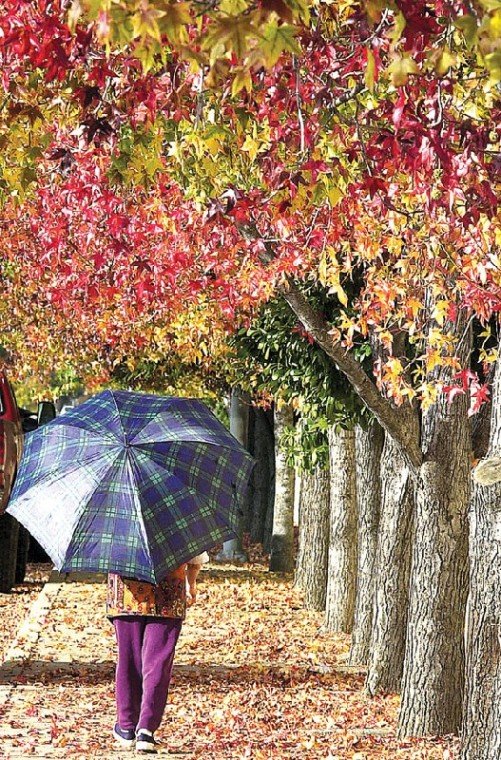As the green leaves of summer begin to fade on trees around the
South Valley, warm yellows, oranges and reds begin to burst forth.
There are even a few purples mixed in, but this yearly palette is
less a color change than a color reveal.
As the green leaves of summer begin to fade on trees around the South Valley, warm yellows, oranges and reds begin to burst forth. There are even a few purples mixed in, but this yearly palette is less a color change than a color reveal.
During spring and summer, leaves on most deciduous trees – or those that lose their leaves – work like thousands of mini-factories, collecting the energy contained in sunlight and using it to process water and carbon dioxide into sugar and oxygen. This process, which provides a tree with its own food source for the year, is called photosynthesis, and the chemical that makes it happen – chlorophyll – is also what gives trees their bright green colors, according to Mary McKenna, a microbiologist at Gavilan College in Gilroy.
In the fall, these emerald leaves go through a process called senescence, or aging. The tree collects the food it’s produced during the warm season, storing it in the woody areas of its trunk and branches. After that, chlorophyll in the leaves begins to break down, revealing the other colors it drowns out during the rest of the year, said McKenna.
Lurking underneath are less common accessory pigments like orange beta-carotine or carotenoids, yellow xanthophylls and multi-hued anthocyanins, which make the trees leaves appear yellow, orange, red and other fall colors, blended like paints on an artist’s canvas, according to David Bruck, a professor of biological sciences and plant-cell biologist at San Jose State University.
“These are called accessory pigments because they help absorb light – not as much as chlorophyll, but in different colors within the light spectrum,” said Bruck. “Chlorophyll absorbs mostly red and blue light, but the other pigments absorb other colors, like green. They tend to be orange and yellow because they don’t absorb those colors, they reflect them.”
Trees begin this process of leaf-shedding based on their own sense of time, said Bruck. Plants are able to determine day length, or rather, the life of the night, deciding the right time to drop their leaves based on a combination of shorter daylight hours and lower temperatures, he said.
It’s a necessary process, said McKenna, because the leaves of a deciduous tree are too fragile to survive harsh winters and lack the insulation to keep the water inside their structures from freezing.
“That would stop all those other processes from going on … so the tree lets the leaves die off and just sort of goes dormant,” said McKenna. “It lives off the stored sugar until spring.”
To ease the leaf’s separation from the tree, special cells at the base of the leaf also change in the fall, creating what is known as an abscission layer. Cells at the base of the leaf’s stem become weak, allowing it to fall from the tree more easily, said McKenna, while other cells in the leaf’s branch form a seal, almost like a small scab, protecting the branch’s health by sealing off the leaf, said Bruck.
As the days and nights begin to warm again, plants revisit their calendars, too, said Bruck.
“Plants are pretty amazing,” Bruck said. “They can measure the number of days below a certain temperature or above a certain temperatures. If the days are interrupted by the opposite, they can still add it up.”
Most plants break out of dormancy when they sense a warming trend, said Bruck, though some will not sprout new leaves until they have experienced a specific number of cold nights.
Next spring, new leaves will grow back to replace the fallen leaves of winter, and the cycle of preparing will begin again.












